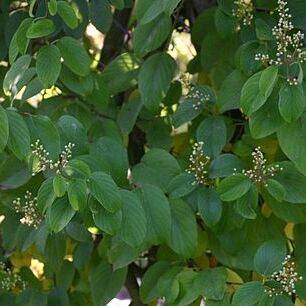Woody vines [shrubs, trees], tendrils absent, unarmed; bud scales present. Stems twining, glabrous [hairy]. Leaves deciduous [persistent], alternate; blade not gland-dotted; pinnately veined, secondary, and usually tertiary, veins strongly parallel. Inflorescences axillary or terminal, paniclelike thyrses [corymblike cymes or fascicles]; peduncles and pedicels not fleshy in fruit. Pedicels present. Flowers functionally unisexual (plants functionally dioecious) [bisexual]; hypanthium patelliform, cupulate, or hemispheric, 2–3 mm wide; sepals 5, staminate spreading, pistillate erect, greenish, triangular [rarely linear or narrowly lanceolate], keeled adaxially; petals 5, cream or yellowish to greenish white, flat, spatulate to lanceolate, short-clawed; nectary fleshy, 10-lobed, filling hypanthium; stamens 5; ovary superior, 2-locular; style 1. Fruits drupes; stone 1, indehiscent.
Unarmed trees or shrubs (or scandent shrubs or lianes or twining vines but not in Africa). Leaves opposite or subopposite (or alternate but not in Africa), petiolate; blades entire, penninerved, the secondary nerves oftendescribing numerous close parallel arcs. Stipules present, intra-axillary (or free but not in Africa). Cymes often reduced to axillary fascicles (or in most species, but not the African ones, aggregated into raceme-like thyrses and the thyrses in turn aggregated into pyramidal panicles). Flowers bisexual, 5-merous. Ovary superior though in some species closely invested by the disk, 2-celled; style short and usually quickly deciduous after anthesis. Drupe elongate, usually 2–3 times as long as thick, with a single elongate 2-celled, usually 2-seeded, stone.
Fls perfect, 5-merous, perigynous with a large annular disk; sep triangular; pet oblong, acute, as long as but narrower than the sep, their margins involute around the filaments; ovary 2-locular; style short, undivided; fr a drupe with thin, leathery exocarp and bilocular stone; twining woody vines with alternate lvs and small greenish-white fls in terminal and axillary panicles. 20+, mostly Old World trop.
Leaves alternate or opposite or subopposite, petiolate; lamina entire, penninerved.
Ovary free or immersed in the disk, 2-locular; ovules 1 in each loculus.
Fruit a drupe with fleshy exocarp and woody endocarp.
Disk cupular or swollen and enveloping the ovary.
Stamens 5, inserted under the edge of the disk.
Petals 5, unguiculate, cucullate.
Stipules small, not spinescent.
Flowers bisexual, pedicellate.
Cymes axillary (or terminal).
Style 2-fid or notched.
Receptacle flattish.
Shrubs or trees.
Sepals 5.
Seeds 2.

